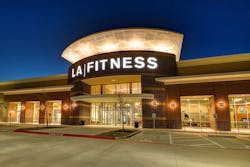Fabcon Precast is built for speed
With more than 500 clubs across North America, wellness juggernaut LA Fitness knows a thing or two about construction. When expansion plans called for a new location in Aurora, Ontario, they looked to Fabcon Precast to extend their reach and shorten the construction cycle. As always, Fabcon’s load-bearing precast panels were up to the task. With the project breaking ground in the final week of August and the promise of a Canadian winter just around the corner, speed was a justified concern for LA Fitness executives. The organization has relied on Fabcon repeatedly on both sides of the border. “Fabcon’s panels are very effective from both a time management and cost control perspective,” says Gary Collins of Fitness International. “The buildings go up extremely fast and we can oftentimes limit excessive winter conditions costs.”
It’s difficult for other construction methods to match Fabcon’s speed, especially when weather is a determining factor–as it almost always is in Canada. With cast-on-site and masonry (CPU) construction, costs climb steadily and progress slows. Once Fabcon’s panels arrived on the Aurora site, their experienced crews had them up in what seemed like no time at all. “They had all the perimeter walls up by the end of at week five. I think it took about six working days. Fabcon definitely saved us time in the field,” said Paul Bloemendahl of Rochon Building. The structural engineer on the project, Renée Tang, P.E., echoed those sentiments: “I’d estimate that using Fabcon’s panels saved us about 20% in overall design time and detailing work.“
Though still somewhat of an anomaly in Canada, Fabcon’s load-bearing precast panels are well-known to LA Fitness and other world-class organizations such as Lowes, Target and UPS. Fabcon’s panels are prized for their ability to shorten construction cycles while delivering a highly- engineered product with excellent thermal properties. Tang admits early on she wasn’t sure what to expect. “We had never done a job with Fabcon or even used structural precast panels for that matter,” she said, “We weren’t necessarily apprehensive, but we definitely had some questions. We were mostly interested in hearing what kind of loads the panels could handle, but we also had some questions about how to work with Fabcon…roles and responsibilities. We just didn’t know what was provided and what was going to be required of us.” Ultimately, things became clear and any doubts were lifted. “As it turned out, Fabcon’s structural precast was perfect for a building like this; the design, the intended purpose, the glazing …it really worked out great.”
As for why structural panels are still somewhat of an oddity, Bloemendahl offered this: “Structural precast is clearly not as popular as it should be…but I think that’s going to change.” Fabcon Precast could not agree more.

